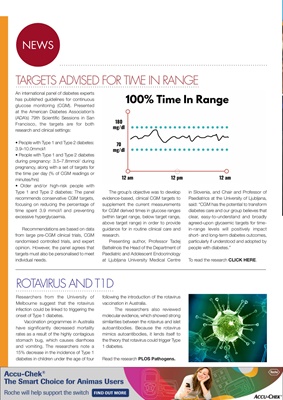
NEWS
TARGETS ADVISED FOR TIME IN RANGE
An international panel of diabetes experts
has published guidelines for continuous
glucose monitoring (CGM). Presented
at the American Diabetes Association's
(ADA's) 79th Scientific Sessions in San
Francisco, the targets are for both
research and clinical settings:
• People with Type 1 and Type 2 diabetes:
3.9-10.0mmol/l
• People with Type 1 and Type 2 diabetes
during pregnancy: 3.5-7.8mmol/ during
pregnancy, along with a set of targets for
the time per day (% of CGM readings or
minutes/hrs)
• Older and/or high-risk people with
Type 1 and Type 2 diabetes: The panel
recommends conservative CGM targets,
focusing on reducing the percentage of
time spent 3.9 mmol/l and preventing
excessive hyperglycaemia.
Recommendations are based on data
from large pre-CGM clinical trials, CGM
randomised controlled trials, and expert
opinion. However, the panel agrees that
targets must also be personalised to meet
individual needs.
The group's objective was to develop
evidence-based, clinical CGM targets to
supplement the current measurements
for CGM derived times in glucose ranges
(within target range, below target range,
above target range) in order to provide
guidance for in routine clinical care and
research.
Presenting author, Professor Tadej
Battelinois the Head of the Department of
Paediatric and Adolescent Endocrinology
at Ljubljana University Medical Centre
in Slovenia, and Chair and Professor of
Paediatrics at the University of Ljubljana,
said: "CGM has the potential to transform
diabetes care and our group believes that
clear, easy-to-understand and broadly
agreed-upon glycaemic targets for timein-range levels
will positively impact
short- and long-term diabetes outcomes,
particularly if understood and adopted by
people with diabetes."
To read the research CLICK HERE.
ROTAVIRUS AND T1D
Researchers from the University of
Melbourne suggest that the rotavirus
infection could be linked to triggering the
onset of Type 1 diabetes.
Vaccination programmes in Australia
have significantly decreased mortality
rates as a result of the highly contagious
stomach bug, which causes diarrhoea
and vomiting. The researchers note a
15% decrease in the incidence of Type 1
diabetes in children under the age of four
following the introduction of the rotavirus
vaccination in Australia.
The researchers also reviewed
molecular evidence, which showed strong
similarities between the rotavirus and islet
autoantibodies. Because the rotavirus
mimics autoantibodies, it lends itself to
the theory that rotavirus could trigger Type
1 diabetes.
Read the research PLOS Pathogens.